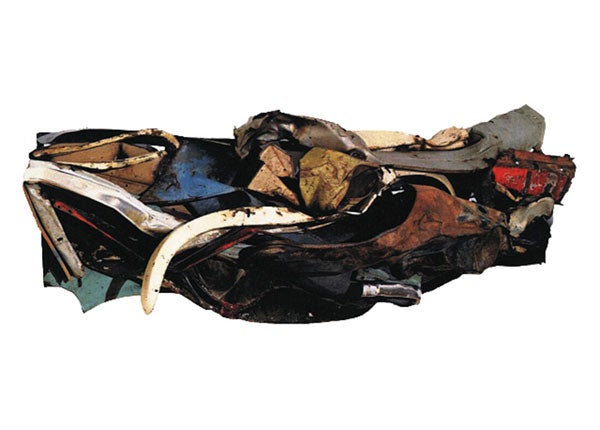 |
February 29, 2012
At the Cantor: Innovations that established the reputations of five contemporary artists
The best tools to teach art history are works of art seen in person. By Robin Wander

John Chamberlain, Bijou, 1961. Painted and chromium- plated steel. Loan courtesy of the Fisher Family. (Credit: © John Chamberlain/Artists Rights Society, New York) Seeing a handful of seminal works of art by important artists in person can be as meaningful as reading the latest tome on art history.
This is especially true when the works of art are carefully selected because they are examples of the innovations that established the reputations of the artists. Such is the case with Wood, Metal, Paint: Sculpture from the Fisher Collection at the Cantor Arts Center through October 2013. Hilarie Faberman, the Cantor's curator of modern and contemporary art, selected works for this long-term installation in consultation with Pamela M. Lee, a professor of contemporary art at Stanford, who will use the exhibition in teaching about sculpture from the 1960s to the 1980s.
"There's no better way to teach art history than to do so with the objects close at hand, particularly sculpture," said Lee. "When a student confronts such work in person, an entirely different relation to the object opens up than when one sees a projected image in a dark classroom."
For Stanford students, having a museum on campus means they can come out of the classroom and go into the gallery for real-life encounters with objects that some will only ever see electronically or on a page.
Copper-Zinc Plain
An example is Carl Andre's Copper-Zinc Plain. A simple description would be, "A floor piece comprised of 36 tiles installed in a square configuration," and a photograph might do little to expand on that description. "To some, that work might initially appear obscure, nonsensical, or simplistic. But when students have the opportunity to engage the art in person, the historical, conceptual and formal issues the work raises spring to life," said Lee.
Lee will be teaching several classes around the six works in the exhibition, including an introduction to art history in which students will learn about abstraction and the importance of site in interpreting works of art, and more specialized surveys on postwar art movements such as pop, minimalism and conceptual art.
In these classes, students will use the works to hone their visual skills and write formal analyses. Both exercises are foundational, Lee said. "They are the building blocks for any art-historical interpretation. So even if a student is more interested in, say, the Renaissance or 18th century painting, such works are wonderful ways to teach basic art history."
Wood, Metal, Paint includes significant pieces dating from 1961 to 2006 by Sol LeWitt, Claes Oldenburg and Martin Puryear, together with Carl Andre's Copper-Zinc Plain and John Chamberlain's Bijou, a large early work made of crushed automobiles and paint. Lee said she wanted to present a cross-section of representative movements and artists from the 1960s to the present. "Each artist was a major figure in his own right. So it's an enormous boon to have their work accessible to Stanford students."
The Fisher family
Over the last decade the Fisher family has loaned works of art from its collection to the Cantor Arts Center. Doris Fisher, a Stanford alum, was a trustee of the university for many years and received the Gold Spike award in 2005.
"The Fisher Collection is unsurpassed in its depth, and the history of art from the 1960s on can be taught with the fine works in their collection," said Faberman. In 2016, the Fisher Collection will move to SF MOMA, when an addition is complete. In the interim, the family continues to lend works of art from its collection to Stanford for the purposes of teaching and enjoyment.
Richard Serra's monumental Sequence, located on the north lawn of the Cantor, is another recent Fisher loan from a roster of artists that has included Ellsworth Kelly, Agnes Martin, Isamu Noguchi and Andy Warhol, as well as other noted contemporary masters.
-30-
|
 |